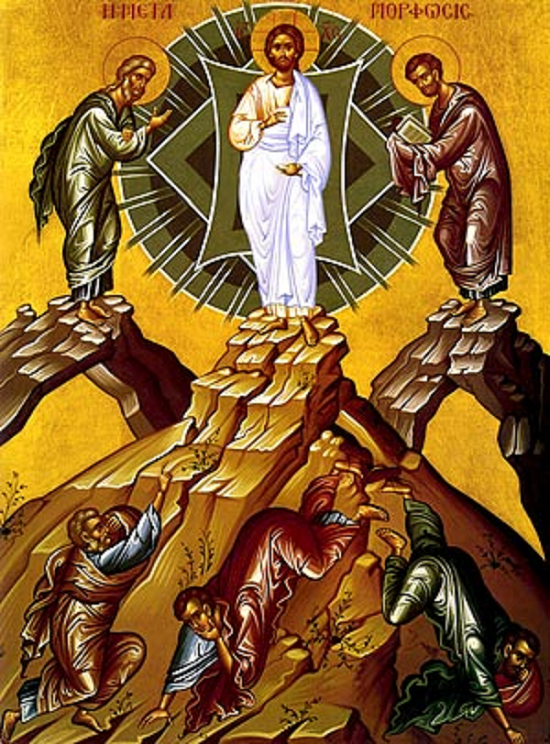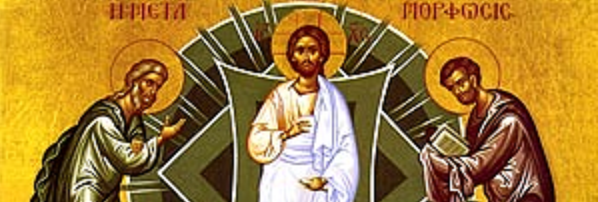The Visible Presence of God
Second Sunday of Lent Scripture Readings

What we find in today’s gospel reading is not so much a literal description of an historical event, but rather an attempt by the first disciples to describe a mystical experience. We can’t ignore the parallel between this event—the Transfiguration—and the events surrounding the Baptism of Jesus in the Jordan River. We find a common manifestation of God’s presence in the בת קול (bat qol)—the voice of God—that reveals Jesus’s true identity in both instances. Both events are positioned at turning points in Jesus’s ministry: one at its outset, and the other beginning the long journey on the road leading to Calvary.
At the Baptism in the Jordan, the mystical event was observed by the crowd, by the disciples, or by Jesus alone, depending on which gospel account you follow. At the Transfiguration, only the “super-Apostles,” Peter, James, and John, were witnesses. As we’ll see in a moment, they may represent God’s chosen people, the faithful remnant, or those few who have responded to God’s call in faith. As such, they represent Christ’s Church. As witnesses, they are brought into a specially privileged position unique in the history of God’s people up until that time.
All the figures used to describe Jesus’s Transfiguration relate directly back to Moses and the covenant between God and Israel. Although generations have tried to identify the location of that “high mountain” we hear about in the gospels, it’s frankly an irrelevant concern. Peter, James, and John are, in effect, reliving the covenant event on Mount Sinai. Jesus is the new Moses—fulfilling the prophet’s promised return, not as the same individual, but in the same role. Jesus is the mediator of a new covenant and a new Law. But this time, the lawgiver is not alone in speaking face-to-face with God. Peter, James, and John—representing us—are there as witnesses. Jesus’s Transfiguration, “his face [shining] like the sun and his clothes as white as light,” is a direct reference to Moses who, after conversing with God, came down the mountain with his face shining so brightly that he had to cover it with a cloth. The Transfiguration is what happens when a human has a personal encounter with God.
As you’ve probably heard before, the appearance of Moses, the Lawgiver, and Elijah, the Prophet par excellence, is a direct reference to the Law and the Prophets—in other words, the Scriptures. Recall that the Jewish people in Jesus’s time had no other name for what we call the Bible. And, incidentally, note that those same Scriptures foretold the return of both men—Moses and Elijah—at the dawning of the Messianic Age. Peter, James, and John, the faithful disciples, realized anew that the one to whom the Scriptures—the Law and the Prophets—had given testimony was standing before them in the person of Jesus.
When Peter suggested that he would set up three tents on the spot—one for Jesus, one for Moses, and one for Elijah—his gesture had both practical and symbolic meaning. On the practical side, the tents were reminiscent of Israel’s wandering homeless in the desert, living in tents. Peter was wanting to make at least semi-permanent their spiritual experience in the presence of the transfigured Jesus. Of course, like all spiritual experiences, it was fleeting.
On the symbolic side, the tents were related to the Jewish Feast of Booths—Succoth—which was the festival commemorating not only their forty years wandering in the wilderness, but more specifically, the covenant and the giving of the Law—the Torah—to Moses on Sinai. Again, all the signs and symbols surrounding Jesus’s Transfiguration identified him as the new Moses, the giver of the new covenant, no longer between God and a distant humanity, but in the person of the Son of God—human and divine—a new covenant in his own blood.
This brings us to the high point of the narrative, the manifestation of the בת קול (bat qol) or the Voice of God. It’s accompanied by the “bright cloud” that overshadowed them. This cloud is the manifestation of the Presence of God. First seen in the burning bush, the bright cloud would cover Mount Sinai whenever Moses would go up to speak to the Lord. When the Israelites were fleeing from the pursuing Egyptians, the bright cloud led them into the desert and stood there behind them, separating them from their enemies and protecting the Israelites. When they built the ark of the covenant to house the tablets of the Law and placed it in the meeting tent the bright cloud descended on it. Finally, when Solomon dedicated the temple in Jerusalem and put the ark into the Holy of Holies, the bright cloud filled the place and made its dwelling there.
The message conveyed by the signs surrounding Jesus, Peter, James, and John was the final word on the identity of Jesus: he is the beloved Son of God to whom the Scriptures bore witness, the One who would himself be the mediator of the new and everlasting covenant not written on tablets of stone but in his own flesh—Emmanuel, God-with-us.
Since the Transfiguration was—and is—a mystical event, and since Peter, James, and John were stand-ins for you and me, what can we say about the Transfiguration today? Where is the bright cloud of God’s glory? Where is the בת קול (bat qol) speaking God’s revelation to us? We can’t see it with the eyes of our bodies or hear it with our bodily ears. The manifestations of the divine Presence are beyond our senses. We can only encounter God’s presence with the eyes and ears of faith. What does it feel like when you know in your gut that you’re in God’s presence? You know the feeling I’m talking about. What does it feel like to hear God whispering in your mind with your own voice, but you know it’s not coming from you? That feeling is your Peter, James, and John moment when you become aware that you’re witnessing the Transfiguration. Can we bring that understanding with us here today? Can we recognize in our readings from Scripture the בת קול (bat qol), the voice of God? Can we sense the bright cloud come to overshadow us right where we are as we experience the new and everlasting covenant in the broken bread and poured-out wine of the Eucharist? We don’t have to climb a mountain to experience the Transfiguration. It’s going on constantly around and within us. All it takes is the eyes and ears of faith to see the Presence of God and to hear God’s voice. You are my beloved daughter, you are my beloved son, with whom I am well pleased.
Get articles from H. Les Brown delivered to your email inbox.

Thank you Les,
Your homily on “The Transfiguration” is one of the finest and most meaningful commentaries I have experienced.
Gary